Human milk supplies ideas for new cardiovascular drugs

A high-fat diet, a lack of exercise, smoking and diabetes promote the development of one of the most common diseases in affluent societies – atherosclerosis, also known as coronary-artery disease. In this cardiovascular disorder, blood fats such as cholesterol are deposited on the walls of blood vessels. Such deposits can be a consequence of small injuries within the vessels, caused for instance by high blood pressure. This triggers the activation of special immune cells, so-called macrophages, which act as a “cleaning squad” in the body. They take up viruses, bacteria or even fat particles, but also cause inflammatory reactions. In addition, the intake of fat alters these clean-up cells. Some of them transform into so-called foam cells, which are also deposited on blood vessel walls, where there is a build-up of layer upon layer of an inflammatory “plaque”. These processes often go unnoticed and remain asymptomatic for many years. But at some point, the deposits can block off the vessel completely, which can often have fatal consequences in the form of thromboses, heart attacks or strokes.
The molecular biologist Ariane Pessentheiner has studied the risk of cardiovascular disease from very different perspectives. Now a senior postdoc at the Institute of Molecular Biology and Biochemistry at the Medical University of Graz, she spent years at the University of California in San Diego researching how components of human milk could be used to slow down the development of atherosclerosis. Currently, the researcher is also working on a new project to establish targeted public communication: the dangers of cardiovascular diseases are to be adequately communicated to younger people who are not yet acutely affected by such diseases in order to draw attention to the urgent necessity of taking preventive measures.
Human milk – a “miraculous substance”
Her research in California is based on scientific findings according to which human breast milk contains up to 200 so-called human milk oligosaccharides (HMOs), certain types of sugar based on lactose. They perform a variety of functions to ensure the optimal nutrition, protection and growth of a baby. By comparison, cow's milk has less than one-tenth of this diversity. “Human breast milk is a true miracle substance. Nature has thus created the ideal nutrition for a child after birth,” explains Ariane Pessentheiner. “The diversity of oligosaccharides plays an important role in this protective effect. But as of today, researchers have been able to actually decipher the function of only a few of them.”
A special feature of some of these sugar molecules is that they are not digested and converted in the intestine, but enter the bloodstream directly and can act on cells found there. Earlier research also revealed that some of the oligosaccharides have anti-inflammatory properties. They support a baby's immune system without causing an excessive and harmful immune response. “Since atherosclerosis is also an inflammatory disease, we had the idea to test the anti-inflammatory properties of the sugar from human milk for a potential future treatment,” notes Ariane Pessentheiner. “The assumption was that the oligosaccharides in question would also have positive effects for people of advanced age.”
Search for the best active substance
As a first step, the researchers wanted to verify that a combination of sugars from donor mothers does indeed possess anti-inflammatory properties. To this end, the sugar mix was added to cell cultures spiked with macrophages, which map a key mechanism of atherosclerosis. The result was clear: “It worked very, very well,” Ariane Pessentheiner says with emphasis. The researchers continued by repeatedly testing individual human milk oligosaccharides to identify precisely the sugar molecules showing the greatest anti-inflammatory power.
The oligosaccharide that ended up as the winner in this step-by-step elimination process was then biotechnologically produced and tested on a mouse model in a preclinical study. One group of the animals which were fed a high-fat diet that promoted atherosclerosis were also given this type of sugar, while the other group served as a control group and received no sugar. Again, Ariane Pessentheiner is happy to report an unambiguous result: “The administration of the sugar was a very successful method of slowing down the development of atherosclerosis. The disease was much less severe in the mice that had been treated.”
Before the anti-inflammatory oligosaccharide can be used as a drug or dietary supplement, however, a great deal more research needs to be undertaken. “It stands to reason that a substance originally derived from human milk cannot be harmful. Nevertheless, tests must be carried out to establish that it shows no side effects even when isolated from the situation in which it occurs naturally. In addition, we need to identify which concentrations are tolerable and appropriate. Once all this has been clarified, something like a milkshake spiked with this sugar could be a helpful application.”
From science to communication
For Ariane Pessentheiner, the Schrödinger Fellowship in San Diego, which was funded by the Austrian Science Fund FWF, was not only an important step in her biochemical research career, but also the starting point for her current involvement in science communication. “Science communication with the public is alive and thriving in the USA. This sparked my interest in becoming more involved with the question of how research results can be better communicated,” Pessentheiner reports. Since returning to the Medical University of Graz, she has been focusing on raising awareness about cardiovascular diseases with the science communication project “Heart Matter(s)”.
“The aim of the project is to get relatively young people from the age of 25 interested in prevention in this area,” explains the researcher. “Although the formation of atherosclerosis begins around this age, hardly anyone pays any attention to the issue.” The project involves a whole range of measures with the central element being the collection of individual stories about cardiovascular disease. “Doctors, nurses, patients or researchers share their personal stories in order to touch people emotionally and offer a low-threshold opportunity to learn more about disease patterns, contributory factors or new research results,” says Pessentheiner. The stories will not only be told live in front of an audience, but they will also be turned into podcasts and made accessible on the project homepage www.herzaehlungen.at. For Ariane Pessentheiner, this project represents a new phase in her career: “Heart Matter(s)” is her starting point to focus entirely on science communication in the future, also in her academic research and teaching.
Personal details
Ariane Pessentheiner has been involved in research on metabolic diseases such as obesity, diabetes and cardiovascular disease for more than twelve years. From 2017 to 2020, Pessentheiner, who holds a PhD in biochemistry, completed a research stay at the University of California in San Diego as part of an Erwin Schrödinger Fellowship endowed with EUR 163,000 by the FWF, to conduct research on the topic of “Human milk oligosaccharides and cardiovascular disease”. That project laid the foundation for her science communication project “Heart Matter(s) - Our heart should be close to our heart”, which will run until 2022 and is also funded by the FWF.
Publications
Pessentheiner AR, Ducasa GM, Gordts PLSM: Proteoglycans in Obesity-Associated Metabolic Dysfunction and Meta-Inflammation, in: Frontiers in Immunology 2020
Xia W., Pessentheiner AR, Hofer DC, Amor M. et al.: Loss of ABHD15 Impairs the Anti-lipolytic Action of Insulin by Altering PDE3B Stability and Contributes to Insulin Resistance, in: Cell Reports 2018
Pessentheiner AR, Huber K., Pelzmann HJ, Prokesch A.: APMAP interacts with lysyl oxidase-like proteins, and disruption of Apmap leads to beneficial visceral adipose tissue expansion, in: FASEB Journal 2017






